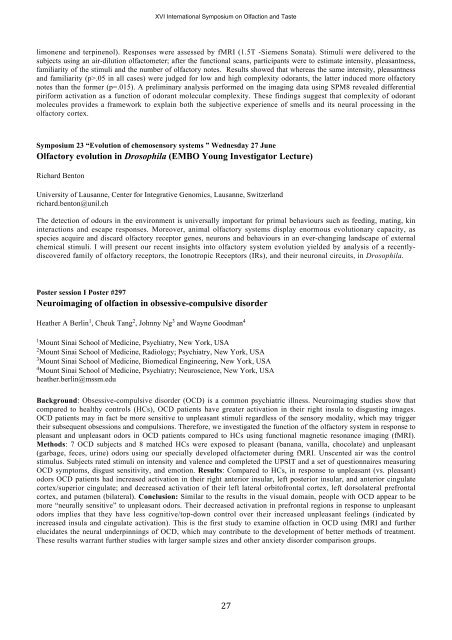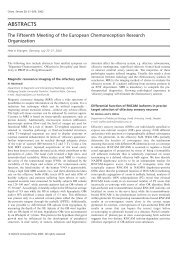XVI International Symposium on Olfaction and Taste - ecro
XVI International Symposium on Olfaction and Taste - ecro
XVI International Symposium on Olfaction and Taste - ecro
Create successful ePaper yourself
Turn your PDF publications into a flip-book with our unique Google optimized e-Paper software.
<str<strong>on</strong>g>XVI</str<strong>on</strong>g> <str<strong>on</strong>g>Internati<strong>on</strong>al</str<strong>on</strong>g> <str<strong>on</strong>g>Symposium</str<strong>on</strong>g> <strong>on</strong> Olfacti<strong>on</strong> <strong>and</strong> <strong>Taste</strong><br />
lim<strong>on</strong>ene <strong>and</strong> terpinenol). Resp<strong>on</strong>ses were assessed by fMRI (1.5T -Siemens S<strong>on</strong>ata). Stimuli were delivered to the<br />
subjects using an air-diluti<strong>on</strong> olfactometer; after the functi<strong>on</strong>al scans, participants were to estimate intensity, pleasantness,<br />
familiarity of the stimuli <strong>and</strong> the number of olfactory notes. Results showed that whereas the same intensity, pleasantness<br />
<strong>and</strong> familiarity (p>.05 in all cases) were judged for low <strong>and</strong> high complexity odorants, the latter induced more olfactory<br />
notes than the former (p=.015). A preliminary analysis performed <strong>on</strong> the imaging data using SPM8 revealed differential<br />
piriform activati<strong>on</strong> as a functi<strong>on</strong> of odorant molecular complexity. These findings suggest that complexity of odorant<br />
molecules provides a framework to explain both the subjective experience of smells <strong>and</strong> its neural processing in the<br />
olfactory cortex.<br />
<str<strong>on</strong>g>Symposium</str<strong>on</strong>g> 23 “Evoluti<strong>on</strong> of chemosensory systems ” Wednesday 27 June<br />
Olfactory evoluti<strong>on</strong> in Drosophila (EMBO Young Investigator Lecture)<br />
Richard Bent<strong>on</strong><br />
University of Lausanne, Center for Integrative Genomics, Lausanne, Switzerl<strong>and</strong><br />
richard.bent<strong>on</strong>@unil.ch<br />
The detecti<strong>on</strong> of odours in the envir<strong>on</strong>ment is universally important for primal behaviours such as feeding, mating, kin<br />
interacti<strong>on</strong>s <strong>and</strong> escape resp<strong>on</strong>ses. Moreover, animal olfactory systems display enormous evoluti<strong>on</strong>ary capacity, as<br />
species acquire <strong>and</strong> discard olfactory receptor genes, neur<strong>on</strong>s <strong>and</strong> behaviours in an ever-changing l<strong>and</strong>scape of external<br />
chemical stimuli. I will present our recent insights into olfactory system evoluti<strong>on</strong> yielded by analysis of a recently-<br />
discovered family of olfactory receptors, the I<strong>on</strong>otropic Receptors (IRs), <strong>and</strong> their neur<strong>on</strong>al circuits, in Drosophila.<br />
Poster sessi<strong>on</strong> I Poster #297<br />
Neuroimaging of olfacti<strong>on</strong> in obsessive-compulsive disorder<br />
Heather A Berlin 1 , Cheuk Tang 2 , Johnny Ng 3 <strong>and</strong> Wayne Goodman 4<br />
1 Mount Sinai School of Medicine, Psychiatry, New York, USA<br />
2 Mount Sinai School of Medicine, Radiology; Psychiatry, New York, USA<br />
3 Mount Sinai School of Medicine, Biomedical Engineering, New York, USA<br />
4 Mount Sinai School of Medicine, Psychiatry; Neuroscience, New York, USA<br />
heather.berlin@mssm.edu<br />
Background: Obsessive-compulsive disorder (OCD) is a comm<strong>on</strong> psychiatric illness. Neuroimaging studies show that<br />
compared to healthy c<strong>on</strong>trols (HCs), OCD patients have greater activati<strong>on</strong> in their right insula to disgusting images.<br />
OCD patients may in fact be more sensitive to unpleasant stimuli regardless of the sensory modality, which may trigger<br />
their subsequent obsessi<strong>on</strong>s <strong>and</strong> compulsi<strong>on</strong>s. Therefore, we investigated the functi<strong>on</strong> of the olfactory system in resp<strong>on</strong>se to<br />
pleasant <strong>and</strong> unpleasant odors in OCD patients compared to HCs using functi<strong>on</strong>al magnetic res<strong>on</strong>ance imaging (fMRI).<br />
Methods: 7 OCD subjects <strong>and</strong> 8 matched HCs were exposed to pleasant (banana, vanilla, chocolate) <strong>and</strong> unpleasant<br />
(garbage, feces, urine) odors using our specially developed olfactometer during fMRI. Unscented air was the c<strong>on</strong>trol<br />
stimulus. Subjects rated stimuli <strong>on</strong> intensity <strong>and</strong> valence <strong>and</strong> completed the UPSIT <strong>and</strong> a set of questi<strong>on</strong>naires measuring<br />
OCD symptoms, disgust sensitivity, <strong>and</strong> emoti<strong>on</strong>. Results: Compared to HCs, in resp<strong>on</strong>se to unpleasant (vs. pleasant)<br />
odors OCD patients had increased activati<strong>on</strong> in their right anterior insular, left posterior insular, <strong>and</strong> anterior cingulate<br />
cortex/superior cingulate; <strong>and</strong> decreased activati<strong>on</strong> of their left lateral orbitofr<strong>on</strong>tal cortex, left dorsolateral prefr<strong>on</strong>tal<br />
cortex, <strong>and</strong> putamen (bilateral). C<strong>on</strong>clusi<strong>on</strong>: Similar to the results in the visual domain, people with OCD appear to be<br />
more “neurally sensitive” to unpleasant odors. Their decreased activati<strong>on</strong> in prefr<strong>on</strong>tal regi<strong>on</strong>s in resp<strong>on</strong>se to unpleasant<br />
odors implies that they have less cognitive/top-down c<strong>on</strong>trol over their increased unpleasant feelings (indicated by<br />
increased insula <strong>and</strong> cingulate activati<strong>on</strong>). This is the first study to examine olfacti<strong>on</strong> in OCD using fMRI <strong>and</strong> further<br />
elucidates the neural underpinnings of OCD, which may c<strong>on</strong>tribute to the development of better methods of treatment.<br />
These results warrant further studies with larger sample sizes <strong>and</strong> other anxiety disorder comparis<strong>on</strong> groups.<br />
27



